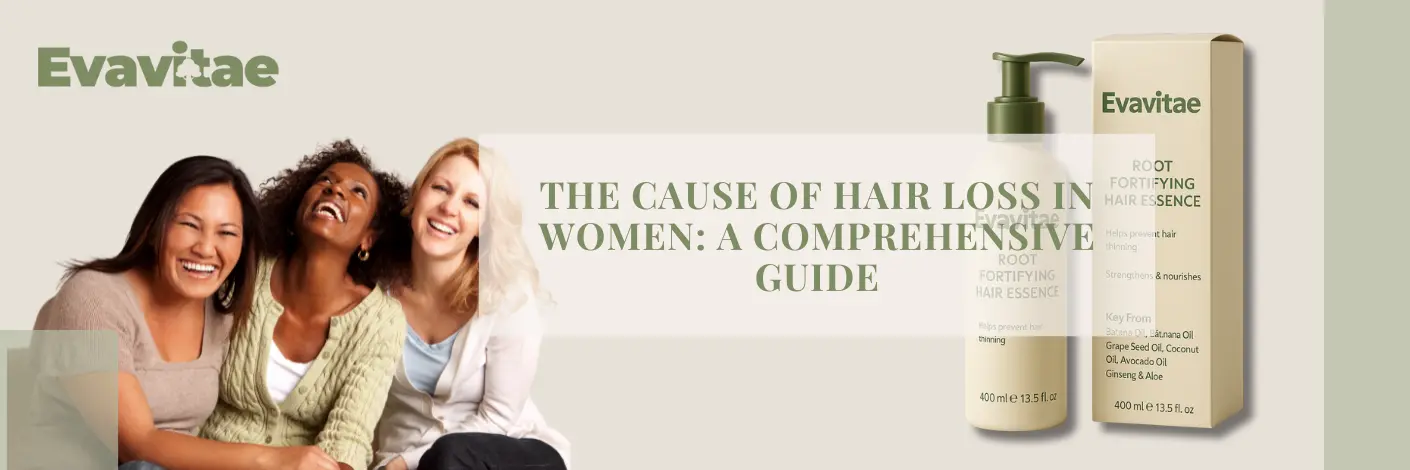
Hair is often described as a woman’s “crown,” playing a vital role in self-image, confidence, and identity. Yet, many women experience unexpected thinning or hair loss at some point in their lives. According to the American Academy of Dermatology, up to 40% of women will notice visible hair loss by the age of 40 (American Academy of Dermatology Association, 2022). While hair loss is commonly associated with men, the causes of hair loss in women are diverse and complex, ranging from hormonal changes to lifestyle factors.
This article explores the major causes of hair loss in women, combining scientific research with gentle, holistic perspectives to help readers understand why it happens and how to approach solutions with care.
1. Hormonal Imbalances
- Androgenetic Alopecia (Female Pattern Hair Loss): This is the most common form of hair loss in women, characterized by thinning on the crown and a widening part line. It is driven largely by genetics and sensitivity to androgens, particularly dihydrotestosterone (DHT) (Shapiro et al., 2022).
- Pregnancy and Postpartum: Many women experience fuller, thicker hair during pregnancy due to higher estrogen levels. However, after childbirth, estrogen levels drop dramatically, often leading to postpartum hair shedding known as telogen effluvium (Malkud, 2015).Hormonal shifts during pregnancy can temporarily alter the hair growth cycle. To explore how to care for your scalp safely during this stage, visit our article on pregnancy hair loss and gentle care routines for expecting mothers.
- Menopause: Declining estrogen and progesterone during menopause shifts the hormonal balance toward androgens, contributing to thinning hair and reduced volume.
- PCOS: One of the most common hormonal conditions contributing to female hair thinning is PCOS, which can elevate androgen levels and disrupt the growth cycle. For a deeper look at this connection and how gentle care can help, explore our article on PCOS hair loss and how effective, gentle routines can support recovery.
2. Nutritional Deficiencies
Hair is a protein-rich structure, and nutrient shortages can quickly disrupt growth.
- Iron Deficiency: Iron is essential for oxygen transport to hair follicles. Low iron levels, common in women due to menstruation, can trigger diffuse thinning (Guo & Katta, 2017).
- Vitamin D Deficiency: Vitamin D supports hair follicle cycling. Deficiency has been linked to various types of hair loss, including alopecia areata (Gerkowicz et al., 2017).
- Other Nutrients: Zinc, biotin, and essential amino acids also play critical roles in keratin production, follicle repair, and scalp health.
Balanced nutrition is key—not only for hair but for overall vitality.
3. Stress and Lifestyle Factors
Stress is more than just “in your head”—it can directly impact your hair.
- Telogen Effluvium: Stressful life events, whether physical (illness, surgery) or emotional (grief, anxiety), can push a large number of follicles into the resting phase. This causes widespread shedding that may last for months (Hughes & Cotterill, 2016).
- Hairstyling Practices: Tight hairstyles (ponytails, braids), excessive heat styling, and chemical treatments can cause traction alopecia and weaken follicles over time.
- Sleep & Lifestyle: Poor sleep, smoking, and excessive alcohol consumption can impair circulation and nutrient delivery to follicles.
Emotional strain and daily stress can silently disrupt the growth cycle. To explore this connection further and learn how to restore inner balance, check out our detailed guide on stress and hair loss.
4. Medical Conditions
Several underlying health conditions can contribute to hair loss in women.
- Polycystic Ovary Syndrome (PCOS): PCOS increases androgen levels, which can shrink follicles and lead to hair thinning.
- Thyroid Disorders: Both hypothyroidism and hyperthyroidism disrupt the hair growth cycle.
- Autoimmune Diseases: In alopecia areata, the immune system mistakenly attacks hair follicles, causing patchy bald spots.
This highlights the importance of seeking medical evaluation if hair loss is sudden or severe.
5. Medications and Treatments
Certain medications list hair loss as a side effect.
- Chemotherapy Drugs: These target rapidly dividing cells, including hair follicle cells, leading to temporary but significant hair loss.
- Other Medications: Antidepressants, blood thinners, and beta-blockers can also contribute to shedding.
Women undergoing such treatments may consider gentle scalp care and protective hairstyles during recovery.
6. Genetics and Aging
7. Emotional Impact and Self-Perception
Beyond the physical, hair loss can deeply affect emotional well-being. Many women report feelings of lowered self-esteem, social withdrawal, or anxiety when hair begins to thin (Cash, 2001). Recognizing that hair loss is common, valid, and not a reflection of personal worth is vital for emotional resilience. Support networks, counseling, and mindful self-care practices can provide healing alongside medical approaches.
8. Approaches to Management
While the cause of hair loss in women varies, a few guiding principles can help:
- Medical Evaluation: Consulting a dermatologist or trichologist is the first step in identifying causes.
- Holistic Care: Supporting scalp health through gentle cleansers, balanced nutrition, and stress reduction often provides long-term benefits.
- Topical and Oral Treatments: Medications such as minoxidil or anti-androgens may be prescribed, though effectiveness depends on the individual cause.
- Gentle Alternatives: Increasingly, women explore safe, non-irritating products that focus on nourishment and scalp balance. For example, Evavitae emphasizes science-backed, gentle care free from harsh chemicals, aligning with women’s need for both efficacy and safety.
9. The Future of Hair Health
Conclusion
Hair loss in women is not a single diagnosis but a multifactorial condition influenced by hormones, nutrition, stress, medical factors, and genetics. While it can be emotionally challenging, awareness and education are powerful tools. By addressing root causes with compassion and science-backed care, women can take steps toward healthier hair and renewed confidence.
The journey is not just about saving strands—it is about nurturing the whole person.
For healthier hair, it’s recommended to use a gentle, non-irritating shampoo. I recommend Evavitae shampoo. Check its ingredient list to see its natural, healthy ingredients. If you’re willing to invest more time in your haircare routine, you can also try its hair care kits.
🌸 Want to understand what drives hair loss—and how to restore balance? See the Hair Loss 101 Hub.
Read more about restoring hair health naturally in the Postpartum Hair Shedding Recovery Hub.
References (APA Format)
- American Academy of Dermatology Association. (2022). Hair loss in women. Retrieved from https://www.aad.org
- Cash, T. F. (2001). The psychology of hair loss and its implications for patient care. Clinical Dermatology, 19(2), 161–166.
- Gerkowicz, A., Chyl-Surdacka, K., Kosciow, K., Bartosinska, J., & Chodorowska, G. (2017). The role of vitamin D in non-scarring alopecia. International Journal of Molecular Sciences, 18(12), 2653.
- Guo, E. L., & Katta, R. (2017). Diet and hair loss: effects of nutrient deficiency and supplement use. Dermatology Practical & Conceptual, 7(1), 1–10.
- Hughes, E. C., & Cotterill, J. A. (2016). Stress and hair loss. Clinical and Experimental Dermatology, 41(6), 563–569.
- Liu, J., Zhu, H., & Yan, H. (2022). Stem cells and hair regeneration: Future perspectives. Stem Cells International, 2022, 1–10.
- Malkud, S. (2015). Telogen effluvium: A review. Journal of Clinical and Diagnostic Research, 9(9), WE01–WE03.
- Shapiro, J., et al. (2022). Female pattern hair loss: Pathophysiology, diagnosis, and treatment. Journal of the American Academy of Dermatology, 86(3), 451–465.
Evavitae products are now available exclusively at www.evavitae.com.




Add comment
You must be logged in to post a comment.